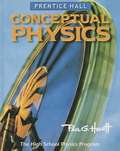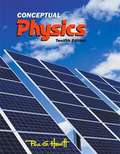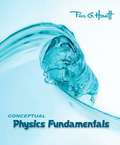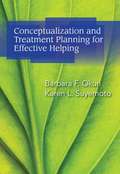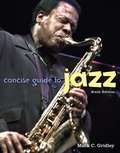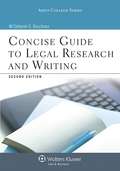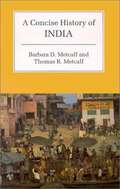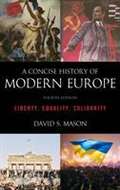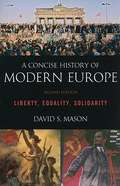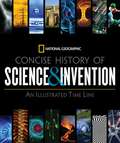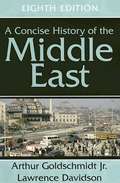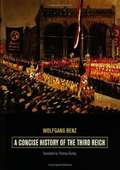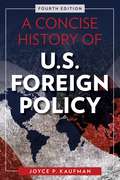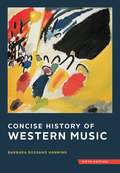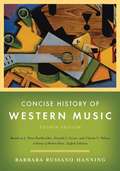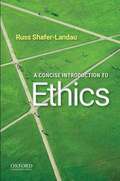- Table View
- List View
Conceptual Physics: The High School Physics Program
by Paul G. HewittThis book guides the reader to see physics as the rules of the physical world, and to teach how the equations of physics reveal the connections in nature, focusing on the physics concepts themselves, their similarities, and their differences. This book contains analogies and clear explanations, more qualitative questions than algebraic problems to discover physics as fascinating, to provide a solid science foundation, and to see that knowledge of physics is important to overall education.
Conceptual Physics: The High School Physics Program
by Paul G. HewittThis seventh edition of the popular and exceptionally well written physics concept text with minimal mathematics contains new material sprinkled throughout, such as a treatment of measurements of the earth, moon, and sun by the early Greeks, capacitors, and more on rainbows. Individual sections have been clarified and updated. Problem sets are now at the end of most chapters. Most problems involve simple calculations that require minimal algebra skills. The text is profusely illustrated in full color with many helpful diagrams and down-to-earth examples. Annotation C. by Book News, Inc., Portland, Or.
Conceptual Physics: The High School Physics Program (3rd edition)
by Paul G. HewittPhysics textbook for high school students.
Conceptual Physics: The High School Physics Program with Expanded Technology (3rd edition)
by Paul G. HewittPhysics textbook for high school students
Conceptual Physics
by Paul G. HewittConceptual Physics, Tenth Edition helps readers connect physics to their everyday experiences and the world around them with additional help on solving more mathematical problems. Hewitt's text is famous for engaging readers with analogies and imagery from real-world situations that build a strong conceptual understanding of physical principles ranging from classical mechanics to modern physics. With this strong foundation, readers are better equipped to understand the equations and formulas of physics, and motivated to explore the thought-provoking exercises and fun projects in each chapter. Included in the package is the workbook. Mechanics, Properties of Matter, Heat, Sound, Electricity and Magnetism, Light, Atomic and Nuclear Physics, Relativity. For all readers interested in conceptual physics.
Conceptual Physics: The High School Physics Program
by Paul G. HewittThis seventh edition of the popular and exceptionally well written physics concept text with minimal mathematics contains new material sprinkled throughout, such as a treatment of measurements of the earth, moon, and sun by the early Greeks, capacitors, and more on rainbows. Individual sections have been clarified and updated. Problem sets are now at the end of most chapters. Most problems involve simple calculations that require minimal algebra skills. The text is profusely illustrated in full color with many helpful diagrams and down-to-earth examples. Annotation c. by Book News, Inc., Portland, Or.
Conceptual Physics: Laboratory Manual
by Paul RobinsonThis lab manual contains 61 activities and 38 experiments. Most activities are designed to provide you with hands-on experience that relates to a specific concept. Experiments are usually designed to give you practice using a particular piece of apparatus.
Conceptual Physics (12th Edition)
by Paul G. HewittConceptual Physics with MasteringPhysics® , Twelfth Edition Paul Hewitt integrates a compelling text and the most advanced media to make physics interesting, understandable, and relevant for non-science majors. The Twelfth Edition will delight you with informative and fun Hewitt-Drew-It screencasts, updated content, applications, and new learning activities in MasteringPhysics.<p><p> Hewitt’s text is guided by the principle of "concepts before calculations" is famous for engaging students with analogies and imagery from the real-world that build a strong conceptual understanding of physical principles ranging from classical mechanics to modern physics.<p> This program presents a better teaching and learning experience–for you.<br> - Personalize learning with MasteringPhysics: MasteringPhysics provides you with engaging experiences that coach you through physics with specific wrong-answer feedback, hints, and a huge variety of educationally effective content.<br> - Prepare for lecture: NEW! 100 Hewitt-Drew-It screencasts, authored and narrated by Paul Hewitt, explain physics concepts through animation and narration. The exciting new Screencasts, accessed through QR codes in the textbook, will enable you to engage with the physics concepts more actively outside of class.<br> - Make physics delightful: Relevant and accessible narrative, analogies from real-world situations, and simple representations of the underlying mathematical relationships make physics more appealing.<br> - Build a strong conceptual understanding of physics: You will gain a solid understanding of physics through practice and problem solving in the book and in MasteringPhysics.
Conceptual Physics, 1999/2002
by Paul G. HewittThe author treats physics conceptually in this book, which means concepts are presented in familiar English, with equations as "guides to thinking." Comprehension of concepts before calculation is the key to understanding. Enjoy your physics!
Conceptual Physics Fundamentals
by Paul G. Hewitt Phillip R. WolfFrom Paul G. Hewitt, author of the market-leading Conceptual Physics, comes his eagerly awaited new, briefer, alternative text, Conceptual Physics Fundamentals. The text extends best-selling author Paul Hewitt's proven pedagogical approach, straight-forward learning features, approachable style, and rigorous coverage, while providing superior supplements and media. The book develops a solid conceptual understanding of physics, while building readers' self-confidence applying their understanding quantitatively. About Science, Equilibrium and Linear Motion, Newton's Laws of Motion, Momentum and Energy, Gravity, Projectiles, and Satellites, Fluid Mechanics, Temperature, Heat, and Thermodynamics, Heat Transfer and Change of Phase, Electrostatics and Electric Current, Magnetism and Electromagnetic Induction, Waves and Sound, Light waves, Properties of Light, Atoms, Quantum Theory, The Atomic Nucleus and Radioactivity. For all readers interested in conceptual physics.
Conceptualization and Treatment Planning for Effective Helping
by Barbara F. Okun Karen SuyemotoOkun and Suyemoto's book addresses theory and skills for continuing beyond the first few sessions with a client, thus helping students take the "next step" from a basic understanding of interviewing skills to a conceptualization of the counseling process. CONCEPTUALIZATION AND TREATMENT PLANNING FOR EFFECTIVE HELPING teaches students how to integrate the many pieces of the helping process (e. g. , theoretical orientation, the person of the therapist, the person of the client, the contexts that affect the clients, the therapy relationship, the context of the therapy, the skills and resources available, etc. ) into a conceptualization that will foster efficacy in creating positive change.
El concierto de la cigarra (¡Arriba la Lectura!, Level L #54)
by Annette Smith Chantal StewartNIMAC-sourced textbook. Es el primer día de clases después de las vacaciones de verano, y Aiden y Logan tienen un maestro nuevo. Al señor Green no le gustan los ruidos fuertes, así que los niños tratan de quedarse callados. Pero cuando las cigarras de los árboles empiezan su concierto, ¡el señor Green se pone muy molesto!
Concise Guide to Jazz (6th Edition)
by Mark C. GridleyThe Concise Guide to Jazz provides an introduction to jazz that is as clear and accurate as Jazz Styles but without as much detail. It is a very useful guide for teachers and students.
Concise Guide To Legal Research And Writing
by Deborah E. BouchouxA clear, well-organized text for the introductory legal research and writing course, designed specifically for paralegal students, Concise Guide to Legal Research and Writing Second Edition covers legal research and legal writing in a concise and pragmatic manner and is ideal for introductory, abbreviated, or online courses.
A Concise History of India
by Barbara D. Metcalf Thomas R. MetcalfA concise history of India since the time of the Mughals comprising the history of British India from the late eighteenth century until 1947, when the subcontinent was split into the two independent countries of India and Pakistan, and of the Republic of India thereafter.
A Concise History Of Modern Europe: Liberty, Equality, Solidarity
by David MasonHighlighting the key events, ideas, and individuals that have shaped modern Europe, this fresh and lively book provides a concise history of the continent from the Enlightenment to the present. <p><p> Drawing on the enduring theme of revolution, David S. Mason explores the political, economic, and scientific causes and consequences of revolution; the development of human rights and democracy; and issues of European identity and integration. He deliberately avoids a detailed chronology of every country and time period, instead emphasizing the most crucial events in shaping contemporary Europe. <p> Fourteen focused chapters address such topical issues as the Enlightenment; the French Revolution and Napoleon; the Industrial Revolution; the theories and impact of Marx and Darwin; the revolutions of 1848, 1917, and 1989; the unifications of Germany and Italy; European imperialism; the two world wars; the Cold War; the evolution and expansion of the European Union; and current issues confronting Europe. Any reader who wants to view the broad sweep of European history will find this book an engaging narrative, supplemented with maps, timelines, sidebars, photos, and a glossary.
A Concise History of Modern Europe: Liberty, Equality, Solidarity
by David S. MasonHighlighting the key events, ideas, and individuals that have shaped modern Europe, this fresh and lively book provides a succinct history of the continent from the Enlightenment to the present. Drawing on the enduring theme of revolution, David S. Mason explores the causes and consequences of revolution: political, economic, and scientific; the development of human rights; and issues of European identity and integration. He deliberately avoids a detailed chronology of every country and time period by emphasizing the most crucial events in shaping contemporary Europe. Fourteen focused chapters address such topical issues as the Enlightenment; the French Revolution and Napoleon; the Industrial Revolution; the theories and impact of Marx and Darwin; the revolutions of 1848, 1917, and 1989; the unifications of Germany and Italy; European imperialism; the two World Wars; the Cold War and decolonization; and the evolution and expansion of the European Union. Any reader needing a broad overview of the sweep of European history since 1789 will find this book, published in a first edition under the title Revolutionary Europe, an engaging and cohesive narrative.
Concise History of Science and Invention: An Illustrated Time Line
by National GeographicFrom the ancient conquest of fire and the first turn of a wheel to the latest in scientific leaps toward the stars, this easy-access history offers a panoramic perspective on humankind's restless quest for the laws, theories, and tools by which we can grasp and master our universe. This concise, concentrated, consistently organized look at our species' key scientific and innovative achievements spans all human history, presenting ten distinct eras from the first glimmers of intelligence to the cutting-edge technologies of the modern world. Within these intuitive divisions, all human scientific endeavors and achievement are divided into four general fields of inquiry and arrayed into four basic geocultural regions for easy comparison in a logical, systematic grid format highlighted by 350 photographs, maps, illustrations, and diagrams that add graphic emphasis to key information. Special two-page feature spreads explore the most revolutionary developments in greater depth; compelling, expertly composed essays and memorable quotations add sparkle; and informative sidebars provide specifically focused items of information about particular inventions, ideas, or themes. Completing this comprehensive approach, an extensive glossary explains unfamiliar terms, and a detailed index makes it a simple matter to follow a particular field or process from its origin through its complete cross-cultural evolution. This is a reference as usefully accessible as it is inherently fascinating.
A Concise History of the Middle East (8th edition)
by Arthur Goldschmidt Lawrence DavidsonThis book focuses on the evolution of Islamic institutions and culture, the influence of the West, the modernization efforts of Middle Eastern governments, the struggle of various peoples for political independence, the course of the Arab-Israeli conflict, the reassertion of Islamic values and power, the aftermath of the Gulf War, and issues surrounding the Palestinian Question.
A Concise History of the Third Reich
by Wolfgang BenzThis highly accessible book at last gives general readers and students a compact, yet comprehensive and authoritative history of the twelve years of the Third Reich--from political takeover of January 30, 1933 to the German capitulation of May 1945.
A Concise History of U.S. Foreign Policy
by Joyce P. KaufmanThe book focuses on the major actors involved in the making of foreign policy and the changing relationships among them. It also explains the major theoretical perspectives within international relations and places key foreign policy decisions within these frameworks. Kaufman concludes with a look forward to the challenges the United States will face in the coming decades. With its strong narrative and use of compelling case studies, the book engages students fully in this crucial topic, encouraging them to form their own ideas about American foreign policy.
Concise History Of Western Music
by Barbara Russano HanningBarbara Hanning's Concise History of Western Music offers students a manageable introduction to the forces that shaped music. Combining concision with the imaginative pedagogy that her text pioneered, Hanning focuses on an essential repertoire of 109 characteristic works--from the Middle Ages to the present--providing students with the cultural and historical context to illuminate the music and remember its significance.
Concise History of Western Music (Fourth Edition)
by Barbara Russano HanningBased on A History of Western Music, by J. Peter Burkholder, Donald Jay Grout, and Claude V. Palisca, Concise History of Western Music, Fourth Edition, offers authoritative coverage of the essential works and genres in Western music history. By setting musical events into a memorable historical and cultural context, Concise History of Western Music provides a history students will read and remember.
A Concise Introduction to Ethics
by Russ Shafer-LandauThis book offers a condensed and exceptionally well-written introduction to the essential moral theories. Based on Russ Shafer-Landau's best-selling primer on ethical theory, The Fundamentals of Ethics, this briefer volume retains the longer one's content advantage over competing books by addressing issues that other texts omit, including the good life (value theory), natural law, and prima facie duties. <p><p>It also incorporates discussion questions and case studies at the end of each chapter, giving students the opportunity to apply ethical theories to real-world moral problems. A perfect companion to Shafer-Landau's anthology, The Ethical Life, this volume's compact size and low price make this book an ideal complement to any course where it is important that students understand moral theories.
